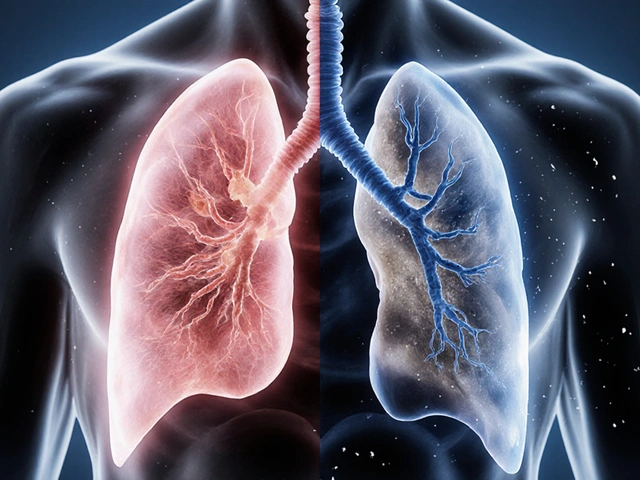
Anxiety Medication Selector Quiz
How quickly do you need relief?
Do you have a history of substance misuse?
What is your primary condition?
Recommended Medication:
TL;DR
- Buspirone works slowly, has no dependence risk, and suits chronic GAD.
- Benzodiazepines (e.g., alprazolam) act fast but can be habit‑forming.
- SSRIs/SNRIs (e.g., escitalopram) are first‑line for long‑term control but take weeks to kick in.
- Antihistamines (hydroxyzine) and beta‑blockers (propranolol) help situational anxiety.
- Anticonvulsants (pregabalin) bridge the gap when rapid relief and low abuse potential are needed.
What Is Buspirone?
Buspirone is a non‑benzodiazepine anxiolytic that primarily targets serotonin 5‑HT1A receptors. Approved in 1986, it’s marketed under the brand name Buspar and is prescribed mainly for generalized anxiety disorder (GAD). Unlike classic sedatives, Buspirone produces a calm rather than a drowsy feeling and does not cause respiratory depression.
Key attributes:
- Typical dose: 5-30mg split 2-3 times daily.
- Onset of therapeutic effect: 2-4weeks.
- Half‑life: ~2-3hours; steady‑state reached in 2days.
- Abuse potential: negligible.
- Common side effects: dizziness, nausea, headache.
Why Look at Alternatives?
Patients often ask, "Buspirone vs alternatives-which works best for me?" The answer depends on three variables: speed of relief, risk of dependence, and co‑existing conditions. Below is a quick cheat‑sheet of the most frequently considered substitutes.
Major Classes of Anxiety Medications
Each class brings its own mechanism, benefits, and drawbacks. Understanding the core differences helps match a drug to a patient’s lifestyle.
Benzodiazepines
Alprazolam is a short‑acting benzodiazepine that enhances GABA activity, delivering rapid anxiolysis within minutes. It’s often used for panic attacks or acute stress.
Other examples include Diazepam and Clonazepam. Their main downside is tolerance and withdrawal risk when used beyond a few weeks.
Selective Serotonin Reuptake Inhibitors (SSRIs) & SNRIs
Escitalopram is an SSRI that blocks serotonin reuptake, gradually stabilizing mood. It’s first‑line for chronic anxiety but may take 4-6weeks to feel full effect.
Other staples: Sertraline (SSRI) and Venlafaxine (SNRI). They carry typical SSRI side effects-sexual dysfunction, weight change-but have low abuse potential.
Antihistamines
Hydroxyzine is an H1‑antihistamine with sedative properties that can calm situational anxiety without dependence risk. It works within an hour but may cause dry mouth and drowsiness.
Beta‑Blockers
Propranolol blocks peripheral beta‑adrenergic receptors, reducing the physical symptoms of performance anxiety (tremor, rapid heart rate). It’s not a true anxiolytic for generalized anxiety, but excels for stage fright.
Anticonvulsants
Pregabalin binds to the α2‑δ subunit of voltage‑gated calcium channels, dampening excitatory neurotransmission. It offers faster relief than Buspirone (often within days) and has minimal abuse risk, though some patients report weight gain.

Side‑By‑Side Comparison
| Drug | Mechanism | Onset | Half‑life | Abuse Potential | Typical Use |
|---|---|---|---|---|---|
| Buspirone | 5‑HT1A partial agonist | 2-4weeks | 2-3h | None | Chronic GAD |
| Alprazolam | GABA‑A positive modulator | Minutes‑hours | 12h | High | Panic/acute anxiety |
| Escitalopram | Serotonin reuptake inhibition | 4-6weeks | 27-32h | Low | Long‑term anxiety, depression |
| Hydroxyzine | Histamine H1 antagonism | 1‑2hours | 20h | None | Situational anxiety, sleep |
| Propranolol | β‑adrenergic blockade | 30‑60minutes | 3-6h | None | Performance anxiety, tremor |
| Pregabalin | Calcium channel α2‑δ binding | Days‑1week | 6-7h | Low‑moderate | Generalized anxiety, neuropathic pain |
Choosing the Right Medication
Consider the following decision matrix when discussing options with a clinician:
- Speed needed: If you need relief tonight, a benzodiazepine or hydroxyzine is logical. If you can wait weeks, Buspirone or an SSRI may be preferable.
- Dependence concerns: History of substance misuse nudges you toward non‑controlled agents like Buspirone, pregabalin, or SSRIs.
- Comorbid conditions: Depression often tips the scale toward an SSRI/SNRI; high blood pressure may make propranolol attractive.
- Side‑effect profile: If sedation is a problem, avoid antihistamines. If sexual dysfunction is a deal‑breaker, consider Buspirone or pregabalin.
Never self‑adjust doses; tapering off benzodiazepines should be medically supervised to avoid withdrawal seizures.
Practical Tips for Switching
- Maintain a symptom diary for at least two weeks before any change. Note anxiety scores, sleep quality, and any side effects.
- If moving from a benzodiazepine to Buspirone, employ a brief taper (e.g., reduce by 0.5mg every 3‑4days) while starting Buspirone at 5mg BID.
- When adding an SSRI, start low (e.g., escitalopram 5mg) and increase after 2weeks; monitor for serotonin syndrome if combined with other serotonergic agents.
- Keep rescue medication (like hydroxyzine) on hand for occasional spikes while the primary drug reaches steady state.
Related Concepts and Next Steps
Understanding Buspirone’s place in therapy also means familiarising yourself with broader topics:
- Generalized Anxiety Disorder - the primary indication for Buspirone.
- Serotonin syndrome - a rare but serious reaction when combining serotonergic drugs.
- Drug‑drug interactions - especially with CYP3A4 inhibitors that can raise Buspirone levels.
- Future reading: "SSRIs vs SNRIs for chronic anxiety," "Long‑term safety of pregabalin," and "Non‑pharmacologic anxiety management (CBT, mindfulness)."
Frequently Asked Questions
Can I take Buspirone with alcohol?
Mixing Buspirone and alcohol isn’t recommended. Alcohol can heighten dizziness and nausea, making both substances feel worse. Unlike benzodiazepines, Buspirone doesn’t intensify sedation dramatically, but the combination still raises safety concerns, especially when driving.
How long does it take for Buspirone to start working?
Most patients notice a reduction in anxiety after 2-4weeks of regular dosing. Full therapeutic effect may take up to 6weeks, so patience is key.
Is Buspirone habit‑forming?
No. Buspirone has no known potential for dependence or withdrawal, which is why it’s a go‑to option for people with a history of substance misuse.
Can I switch from an SSRI to Buspirone?
Yes, but a gradual cross‑taper is advised. Because both affect serotonin, overlapping high doses can trigger serotonin syndrome. A typical plan is to reduce the SSRI by 10mg every 1-2weeks while introducing Buspirone at a low dose.
Are there any foods I should avoid while taking Buspirone?
Grapefruit juice can inhibit CYP3A4, potentially raising Buspirone plasma levels and side effects. It’s safest to limit citrus‑based products or discuss with a pharmacist.
Which anxiety drug works the fastest?
Benzodiazepines like alprazolam or lorazepam produce relief within minutes to a few hours, making them the quickest option. However, they carry the highest misuse risk.
Is Buspirone safe during pregnancy?
Animal studies haven’t shown major teratogenic effects, but human data are limited. Most clinicians prefer non‑pharmacologic therapies or low‑risk SSRIs during pregnancy, so the decision must be individualized.




brajagopal debbarma
September 26, 2025So buspirone takes weeks to work? Guess I'll just sit here and anxiety until my brain turns to mush. Meanwhile my cat knows how to chill better than this drug.
Carly Smith
September 27, 2025Why are we even talking about meds when therapy is free and doesn't make you drowsy or weird? People just want a quick fix instead of facing their problems.
Caden Little
September 29, 2025This is actually super helpful! I switched from alprazolam to buspirone last month and yeah it took a bit but now I'm not waking up foggy or scared to drive. Also hydroxyzine on bad days is a lifesaver 😊
Michael Ferguson
September 30, 2025Let me tell you something about modern psychiatry. You're all just chasing chemical solutions because you're too lazy to meditate or go outside or talk to someone who doesn't get paid to listen. SSRIs are just corporate placebo pills dressed up as science. And don't get me started on how pregabalin got pushed by pharma to replace benzos while quietly turning people into walking doughnuts. You think you're healing but you're just trading one dependency for another. And the fact that you're reading this instead of journaling or doing yoga? That says everything.
Sebastian Brice
September 30, 2025I get why people hate buspirone for being slow but honestly? It's the only thing that didn't make me feel like a zombie. I tried SSRIs, benzos, even that weird herbal stuff. Buspirone didn't kill my libido or make me cry at commercials. Still takes time but at least I'm not a shell of myself. Also side note: grapefruit juice is a sneaky little menace. Learned that the hard way.
Kurt Stallings
September 30, 2025The real issue is not the drugs. It's that we've medicalized normal human distress. Anxiety isn't a disorder. It's a signal. And now we're just pharmacologically silencing the messenger.
Angie Creed
October 1, 2025You know what's ironic? People who prescribe buspirone think they're being 'responsible' and 'non-addictive' but they're just delaying real healing. Meanwhile, the person on the other end is still crying in the shower at 3am because their brain hasn't caught up to the serotonin levels they're forcing it to accept. We're treating symptoms like they're the disease. And that's not medicine. That's performance art.
Patrick Klepek
October 2, 2025I used to think benzos were the devil until I had a panic attack during a flight and alprazolam saved my life. Now I use it like a fire extinguisher - only when the house is burning. Buspirone? It's the smoke detector. Both have their place. Just don't pretend one is morally superior to the other.
robert maisha
October 4, 2025The ontological framing of anxiety as a pharmacological problem obscures the existential dimension of human suffering. We have replaced the dialectic of selfhood with chemical substitution. The 5-HT1A receptor is not a solution but a symptom of our alienation from the phenomenological ground of being. One cannot pharmacologically reconcile the absurdity of existence with a molecule that modulates synaptic transmission. The true therapeutic act lies not in the tablet but in the confrontation with finitude. And yet we reach for the pill because the silence of the cosmos is too loud to bear.
Jim Aondongu
October 5, 2025All this talk about meds and none of you mention exercise or sunlight. I was on everything you listed and guess what fixed me? Walking 30 minutes a day and stopping doomscrolling. Medications are just crutches for people who won't change their lives